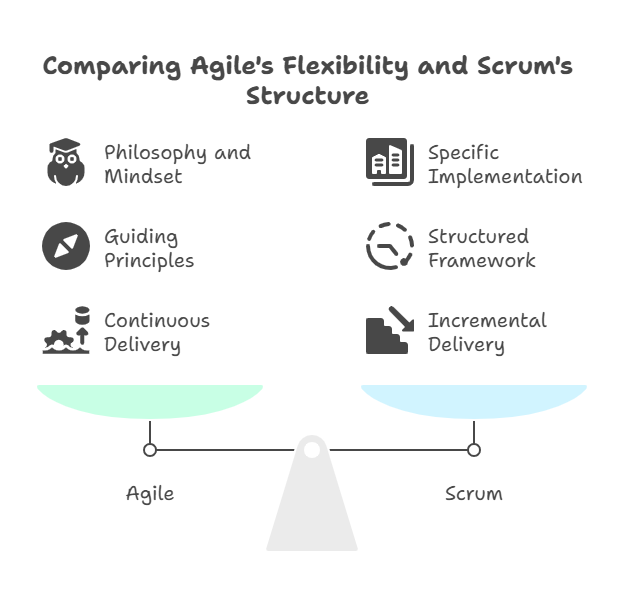Agile vs Scrum: Key Differences and When to Use Each
Understand the fundamental differences between Agile methodology and Scrum framework. Learn when to use each approach for optimal project management results.
Understanding Agile and Scrum
Many professionals confuse Agile and Scrum, but they serve different purposes in project management. Agile represents a philosophy and mindset centered around flexible, iterative development, while Scrum provides a specific framework for implementing Agile principles in practice. Understanding this distinction helps teams choose the right approach for their projects.
What is Agile Methodology
Agile is a project management philosophy that employs principles and values to help teams respond to change effectively. The Agile Manifesto, created in 2001, outlines four core values: individuals and interactions over processes and tools, working software over comprehensive documentation, customer collaboration over contract negotiation, and responding to change over following a plan.
Key characteristics of Agile include:
- Iterative development with continuous delivery
- Customer satisfaction through early and continuous delivery
- Adaptive planning that welcomes changing requirements
- Collaborative approach between cross-functional teams
What is Scrum Framework
Scrum is an Agile framework that helps teams structure their work into short development cycles called sprints. According to Atlassian's Agile guide, Scrum takes Agile principles one step further by creating structure that helps teams implement Agile principles in their daily work.
Scrum features include:
- Fixed-length sprints typically lasting 1-4 weeks
- Three key roles: Product Owner, Scrum Master, and Development Team
- Specific ceremonies like daily stand-ups, sprint planning, and retrospectives
- Artifacts including product backlog, sprint backlog, and increment
Key Differences Between Agile and Scrum

Nature and Scope
The fundamental difference lies in their nature: Agile is a philosophy and mindset while Scrum is a specific implementation framework. As noted in Simplilearn's comparison, Scrum is a methodology that software development teams follow, while Agile is a philosophy about how software is delivered to customers.
Structure and Prescriptiveness
Agile provides guiding principles without specifying exact processes, allowing teams to adapt the methodology to their needs. Scrum, however, offers a structured framework with defined roles, ceremonies, and artifacts that teams must follow.
Delivery Approach
One key difference highlighted by Northeastern University is that Scrum creates "shippable" portions of the project throughout development rather than delivering everything at the very end. This incremental delivery approach is a specific implementation of Agile's continuous delivery principle.
When to Use Agile vs Scrum
Choose Agile When:
- Your project requires maximum flexibility and adaptability
- You're developing a new product with uncertain requirements
- Your team needs to respond quickly to market changes
- You want to establish a collaborative, customer-focused culture
Choose Scrum When:
- You need a structured framework to implement Agile principles
- Your project can be broken down into fixed-length iterations
- You want clear roles and responsibilities for team members
- You need regular checkpoints and progress visibility
Implementing Both Approaches
Many successful teams use Scrum as their primary framework for implementing Agile principles. As Reddit discussions note, Scrum provides the concrete structure needed to bring Agile values to life in software development projects.
For project managers and teams looking to visualize these methodologies, ClipMind offers tools to create mind maps that can help clarify the relationships between Agile principles and Scrum practices. The platform's Project Planner can assist in mapping out your Agile or Scrum implementation strategy.
Conclusion
Understanding that Agile represents the philosophical foundation while Scrum provides a practical framework is crucial for effective project management. Both approaches prioritize flexibility, customer satisfaction, and iterative development, but they operate at different levels of abstraction. By recognizing these differences, teams can make informed decisions about which approach best suits their project needs and organizational context.
 ClipMind
ClipMind